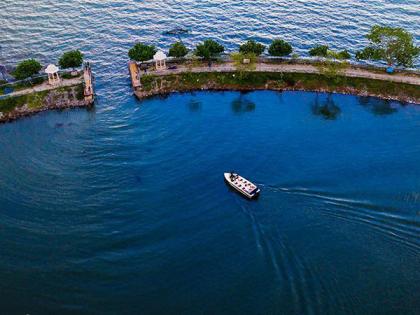Indian mission in New York calls on nature enthusiasts to visit Chilika Lake in Odisha
By ANI | Published: May 17, 2024 01:35 AM2024-05-17T01:35:39+5:302024-05-17T01:40:06+5:30
New York [US], May 17 : The Indian Consulate General in New York on Thursday called on tourists worldwide ...

Indian mission in New York calls on nature enthusiasts to visit Chilika Lake in Odisha
New York [US], May 17 : The Indian Consulate General in New York on Thursday called on tourists worldwide to explore the tranquil charm of Chilika Lake, located in the Indian state of Odisha.
As it urges people to visit Asia's largest brackish water lagoon, it also encourages them to experience the shimmering waters and discover a sanctuary for wildlife and culture, calling it a "must-visit destination for nature enthusiasts."
In a post on X, the Indian consulate in New York said, "Explore the tranquil charm of Chilika Lake, Asia's largest brackish water lagoon, nestled in the heart of Odisha! Glide through its shimmering waters and discover a sanctuary for wildlife and culture. A must-visit destination for nature enthusiasts!"
Situated on the east coast of India and connected to the Bay of Bengal through a narrow sea mouth, Chilika is also a lagoon. Like all coastal lagoons, its waters are rich with life.
It is the largest brackish water lagoon with estuarine character that sprawls along the east coast. It is the largest wintering ground for migratory waterfowl found anywhere on the Indian sub-continent. It is one of the hotspots of biodiversity in the country, and some rare, vulnerable, and endangered species listed in the IUCN Red List of Threatened Animals inhabit the lagoon for at least part of their life cycle, according to the Chilika Development Authority official website.
A survey of the fauna of Chilika carried out by the Zoological Survey of India in 1985-87 recorded over 800 species in and around the lagoon. This list includes several rare, threatened, and endangered species, including the Barakudia limbless skink. On account of its rich biodiversity and ecological significance, Chilika was designated as the first "Ramsar Site" of India.
The Nalaban Island within the lagoon is notified as a bird sanctuary under the Wildlife (Protection) Act. The National Wetlands, Mangroves, and Coral Reefs Committee of the Ministry of Environment and Forests, Government of India, has also identified the lagoon as a priority site for conservation and management. The lagoon is a highly productive ecosystem, with rich fishery resources. The rich fishing grounds sustain the livelihood of more than 0.15 million fisherfolk who live in and around the lagoon.
The waterspread area of Chilika varies between 1,165 and 900 sq. km during the monsoon and summer, respectively. A 32-kilometre-long, narrow outer channel connects the main lagoon to the Bay of Bengal, near the village of Motto. The mouth connecting the channel to the sea is close to the northeastern end of the lagoon.
High tides near this inlet mouth drive saltwater through the channel during the dry months, from December to June. With the onset of the rains, the 52 rivers and rivulets flowing into the Chilika are in spate, causing freshwater currents that gradually push the seawater out. Due to the littoral drift prevailing along the east coast, the inlet mouth constantly changes position.
The lagoon itself can be broadly divided into four ecological sectors based on salinity and depth: the southern zone, central zone, northern zone, and outer channel. Several islands are present in the lagoon, both inhabited and uninhabited, prominent among which are Krushnaprasad, Nalaban, Kalijai, Somolo, Honeymoon, Breakfast, and Birds Island.
Disclaimer: This post has been auto-published from an agency feed without any modifications to the text and has not been reviewed by an editor
Open in app

